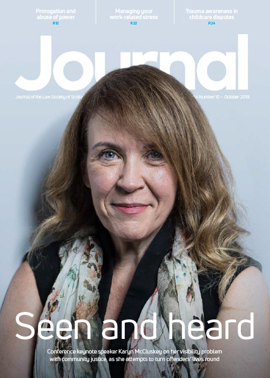Being trauma-informed – in practice

Awareness within the legal profession of the impact of adverse childhood experiences is rapidly growing. The Journal has featured a number of articles this year alone. While discussion on the usefulness of a “scoring” system such as the ACE questionnaire is both appropriate and necessary, a more pressing issue for practitioners is that we now know that traumatic events (including acrimonious litigation) have a lifelong impact on children’s health and wellbeing. So what do we do with that knowledge?
In this article we explore questions of trauma and consider practical ways to work with a trauma-aware lens.
What is trauma?
Trauma can be defined in different ways in different contexts. When we are talking about “trauma-informed” practice, trauma refers to experiences that have harmed or threatened someone’s psychological integrity, impacting on their behaviour and relationships over time.
The social context in which an adverse experience occurs, who supports you and how, can be the difference between a negative event and a traumatic experience. Those whose adverse experiences are created by the people within their social context (e.g. parents, partners) are at particular risk. This is referred to as interpersonal trauma and has specific relevance when engaging vulnerable clients.
Rupture and repair
Attachment theory refers to the three stages of connection, rupture and repair within relationships. Rupture, i.e. the loss of connection, is a normal part of the process, so long as it leads to strategies that allow the relationship to be repaired again.
Many of the cases which practitioners will litigate are those where relationships have become stuck at the rupture stage.
This can be due to many factors: past trauma, lack of opportunity to learn how to repair connections due to abusive or misattuned early relationships, or particular dysfunction within the given relationship. Yet the risk is that the adversarial court process maintains and/or mirrors families in rupture, and the crucial repair stage is never attained.
Introducing trauma-informed practice
Transforming Psychological Trauma: A Knowledge and Skills Framework for the Scottish Workforce (2017), produced by the NHS, outlines what is required when working with people who have been traumatised. The framework represents a systems level approach within which are steps that individuals can introduce into their practice. The aim is to help workforces realise the prevalence of trauma, recognise different ways in which trauma can affect people, support people affected by trauma and avoid trauma-related distress, and ensure personnel are well supported when responding to trauma. The framework is available online and is a recommended resource for workplaces across Scotland. Below we consider some of the key messages (realise, recognise, resist, respond) in relation to the practice of family law.
Realise prevalence of trauma
The prevalence within family law of people affected directly by trauma, past or present, will be high. Children may have been abused, separated from carers, or be caught up in their parents’ acrimony. Parents might have had a child removed, be the victim of abuse or be accused of being abusive. Troubled parents have often experienced interpersonal maltreatment during their childhood. Practitioners need to realise that many of their clients will be directly affected.
Recognise impact of trauma on the individual
Individuals with histories of unresolved trauma can present in different ways. Underpinning these are coping strategies designed to avoid re-experiencing fear and isolation. Coping strategies that were once adaptive are now maladaptive, but can still serve to make the situation manageable for the individual. For example, some people may use strategies of coercion, control and anger to achieve their goals. For these individuals, the court process may give them the opportunity to feel powerful and the court setting allows them a chance to assert their strongly held views. Others may be anxious and avoidant, missing appointments, failing to turn up or presenting inconsistent evidence when placed under pressure.
When traumatised individuals engage in relationships with solicitors, or the legal system itself, they bring expectations based on past experiences. Some may struggle to trust their solicitor or anticipate that the legal system will let them down. Some may become overly dependent on their solicitor and hold unrealistic expectations about what can be achieved for them. Some solicitors may feel their worth lies in fulfilling the hopes and expectations of vulnerable clients, because of their own need to feel valued and successful.
Furthermore, because of their own trauma, some parents cannot tolerate the emotional needs of their children and use coping strategies, such as denial and/or blame, to protect themselves from the reality of how their parenting impacts on their child. That traumatic impact can then be lost if the child is not placed at the centre of the legal process.
Resist re-traumatisation
Aspects of the legal system, such as being asked to recall traumatic events, being exposed to an alleged abuser, or the court experience reminding them of the disempowered feelings associated with past trauma, can trigger an individual’s trauma-related stress or cause re-traumatisation (feeling as bad as when the trauma was actually happening).
Trauma can play out powerfully within a court environment. Emotions are heightened and although steps are taken to minimise discomfort, attending court can in itself be a traumatic event. The nature of the hearing, be it a proof, child welfare hearing, or children’s panel, is irrelevant to the person experiencing it.
Often, trauma histories in permanence cases are the most explicit: abuse, fear, isolation, disempowerment and loss are often cornerstones of the parent’s history. The court process lays this bare: the rupture is the only focus, and the parent, who may feel briefly engaged by having the chance to fight for their child, will often re-experience the abuse, powerlessness and loss that has played out in their lives for years.
In disputes over contact and residence there is often a stark contrast between parents’ positions and, as with permanence cases, trauma histories are brought to the fore. The conflict between parents is magnified by the adversarial nature of proceedings, and parents’ dysfunctional interpersonal interactions are maintained rather than resolved. Lucey et al point out: “Unresolved discord between parents is one of the major stressors for a child, potentially affecting all aspects of their emotional life, and continuing disharmony is consistently shown to have more adverse effects than parental separation of itself.” Professionals must always ask themselves whether the parent is presenting as child-centred or as consciously or unconsciously prioritising their own needs over those of their child, leaving their child vulnerable to further trauma.
Ensure practitioners are well supported
It must also be recognised that legal practitioners are not immune from trauma, whether due to their own historic life experiences or the experience of secondary trauma in response to the stories they hear.
An awareness of one’s personal motivations for the work we do, and attending to our emotional reactions, is important. Professionals have their own vulnerabilities. For example, a solicitor may be affected by a case in a manner that makes it difficult to give the most effective representation to the individual(s) involved; for some parents the decision to fight their case through the court might be more of a reflection of their psychological need to protect themselves from facing up to and addressing the reality of their limitations as a parent. A solicitor, perhaps for reasons associated with their own needs, might be determined to fight for their client’s rights, losing sight of when that fight is no longer in their client’s best interests, potentially causing additional trauma. As a result, legal processes can become the forum within which past trauma is re-enacted, not just by families, but in parallel by all individuals (lawyers, experts, sheriffs) involved in the case (for example, abuse dynamics being acted out between the different parts of the system).
Reducing trauma-related distress
It is important to hold in mind that a person’s behaviour or reactions at all stages of their journey through the legal system might be trauma-related. Practitioners should try to work in a way that reduces the risk of trauma-related distress by maximising choice, collaboration, trust, empowerment, safety and self-care. The adversarial nature of litigation, the requirement for the court to make long-lasting decisions in the space of what can be very short hearings, together with the financial pressure of running a legal aid case, can reduce the availability of these factors for practitioners. While litigation can be unavoidable, alternatives such as mediation and collaborative practice (where appropriate) might provide a better framework for trauma-informed resolution. Where cases are in court, practitioners can be mindful of unnecessary arousal from the court environment, and think about trauma triggers.
We conclude with ideas and examples of where there may be scope to put these concepts into practice, although it is recognised that the infrastructure often limits opportunities to do so.
Examples of trauma-aware practice ideas for legal practitioners in their daily practice
Choice
- Some clients benefit from choosing the sex of their lawyer. Gender relationships may play out if this is not considered in advance.
- Explore vulnerable witness measures to allow clients to give evidence without an ex-partner observing.
Collaboration
- Engage your client to co-construct an understanding of the most appropriate way forward for them and their child.
- Consider what might be informing the behaviour of the other parent in contact/residence disputes. Help your client think about how best to respond, and remind them that their child’s relationship with the other parent is not the same as their own.
- Consider whether alternative forms of dispute resolution might reduce trauma and enhance self-determination.
Trust
- Be clear about what will happen, when and why.
- Get in touch when you say you will.
- If someone else is attending court with your client in your absence, tell your client this will happen and let them meet the other legal adviser in advance.
Empowerment
- Encourage people affected by trauma to access services, supports and interventions to improve recovery. This could include parenting interventions.
- Find time to listen to the client’s experiences and understanding of conflict; use this to inform decisions and advice.
- Ensure clients know what they can do to enable change, find solutions and focus on their child: this can be more powerful than focusing on a case to undermine the other party.
Safety
- Help regulate emotions, both your own and your clients’. This includes acknowledging distress. When a client is emotionally contained, they are more likely to be able to listen to legal advice and make decisions that are informed by their and their child’s best interests, rather than be driven by their emotional reaction.
- Allow clients the chance to become familiar with meeting spaces and courts. This includes simple things like knowing exactly where to report on arrival, where the toilets are, what will happen through the day (including the potential for delays), and the layout of the court.
- Ensure clients are prepared for what questions might be asked in court.
- Cross-examination can be particularly distressing. Be aware that you could be questioning a vulnerable adult in court and consider how to cover your points without triggering trauma. Children will not benefit from decisions informed by parental distress rather than parental capacity.
- Be mindful that the adversarial court process may mirror the relationships of parents. For example, abusive, critical or undermining behaviour from one solicitor to another, or excessive criticism of one expert to another, entrenches conflict, exacerbates distress and ignores the needs of children. Respecting the contribution of “the other side” is a way of modelling safe relationships.
Self care
- Spend time trying to understand what drives your behaviour, why some cases mean more to you than others, and when your own desires influence decisions.
- Seek support and supervision from peers and mentors. If something specific has been triggered for you emotionally, seek help and guidance from whatever source is most appropriate, whether that is colleagues, friends or professionals.
- Allow yourself reasonable goals for time management, travel, relaxation, personal and professional development.
Conclusion
There are no easy answers for practitioners in the field of family and child law. The decisions which we help clients to make can echo through generations.
A simple recognition and understanding that the processes which we guide people through almost always involve trauma can be enough.
A working knowledge of the interpersonal effect of trauma can help us to work with our clients to make decisions that avoid further trauma.
Not all of the practical suggestions contained in this article will be possible to implement in every case. If, however, our family and child law practice begins to implement elements of the information and knowledge that we have about trauma, we are moving in the right direction not only in representing our clients fully and ethically but also in contributing to a more lasting benefit for the children involved. Guidance is available to facilitate the development of trauma-informed practice on a systems level (The Scottish Psychological Trauma Training Plan, 2019). Clinical psychologists acting as implementation co-ordinators for the framework across Scotland can be contacted via the NES website www.nes.scot.nhs.uk
Regulars
Features
Briefings
- Law fair for the high street
- It's time for home truths
- No hope at age 16?
- Drug driving
- Licensing and the public health objective
- Constructing the new framework
- Scottish Solicitors' Disipline Tribunal
- Calling-up: the questions continue
- Reverse charge: don't sit back
- The anomaly that is immigration bail







